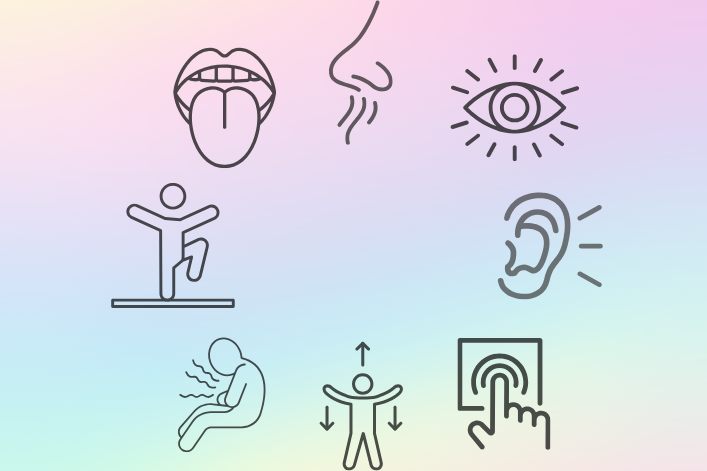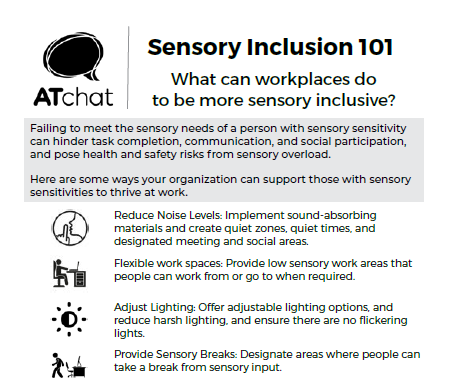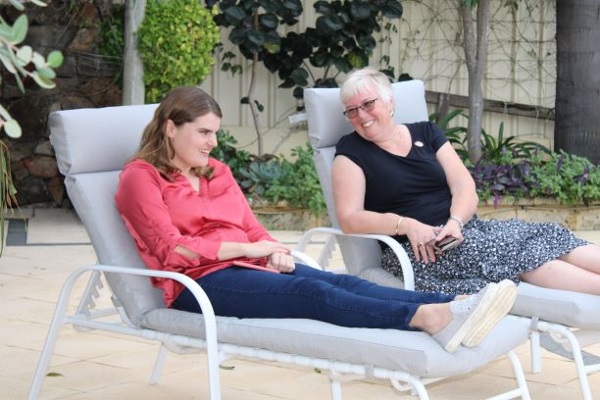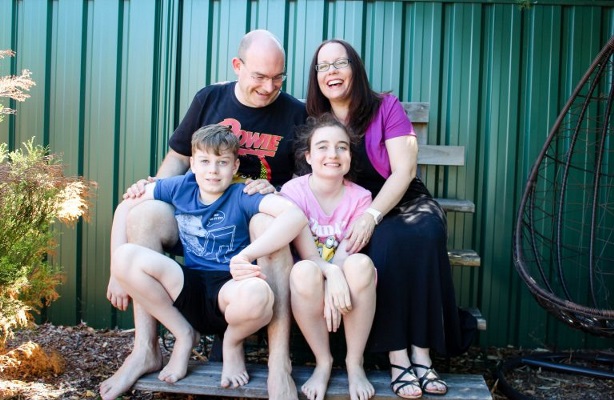Sensory Sensitivity Inclusion 101
Co-designed with Disability Inclusion Consultant Samantha Rowe

Samantha (Sam) Rowe (she/her) is an intersectional disability advocate, disability inclusion consultant and researcher with lived experience of Autism, ADHD, and a neurological disability. She brings both professional and personal insight to her cultural sector research and inclusion work, with a strong focus on sensory sensitivity inclusion.
Sam undertook accessibility and advocacy work and research at the University of Queensland, UQ Art Museum, Ipswich Libraries, and currently with Griffith University. Sam’s consultancy work outside of the cultural sector includes co-design projects with Queenslanders with Disability Network, consumer representative work, and advisory and reference group work.
This resource, and others to come focusing on sensory sensitivity inclusion, were co-designed with Sam.

What is sensory sensitivity inclusion?
Everyone deserves to be able to participate in society, regardless of their disability. This includes people who experience sensory sensitivity. Sensory sensitivity inclusion is about creating environments and experiences that are welcoming, accessible, and safe for those who have sensory sensitivity.
What is our sensory system?
The human body has eight sensory systems that process incoming information and send that information to our brain.
The eight (8) senses include:
- Visual - sight, including colour, brightness, shape, orientation, and motion.
- Auditory – sound, including people talking, nature, cities, background noise, loud noise.
- Olfactory – smell, including strong food smells, personal and domestic scents and cleaners.
- Gustatory – taste, including new flavours, strong tastes, disliked flavours.
- Tactile - touch, pressure, temperature, pain.
- Vestibular – balance, including dizziness, vertigo, or feeling like falling.
- Proprioception - position, location, orientation and movement of the body muscles and joints, including motion from a vehicle, being bumped in a crowd, spinning, jumping, wearing heavy clothing.
- Interoception - internal physiological and physical sensors, including hunger, thirst, tiredness, body temperature, heart and breathing rates, muscle tension, itchiness, nausea, needing to use the bathroom.
Our sensory systems tell our brain about the environment around us and what our bodies are experiencing. Sensory processing is how our brain organises, interprets, prioritises and processes this information. When the brain is operating and processing this information effectively, is it able to control the degree to which it is affected by incoming sensory information. This basically means that a neurotypical brain sorts through all the important information it wants to concentrate on, and then disregards all other irrelevant information.
.png?sfvrsn=6bc1ba44_1)
What is sensory sensitivity?
Sensory inputs are cumulative and build upon each other making it more difficult for the brain to process. Those who experience hypersensitivity to sensory inputs experience every sensory input at the same time, with their brains unable to ignore the irrelevant inputs.
What is sensory overload?
- Fight / Meltdown - behaviours may include verbal outbursts, crying, being aggressive, something that may look like a tantrum, or harm to self or others.
- Flight - a common response is to remove oneself from the situation. A person may try to hide or run away from the cause of the overload.
- Freeze / Shutdown - a person may freeze and become unresponsive due to the brain stopping processing information. Some people may start repetitive movements such as rocking, fiddling, or banging part of their body on something.
Sensory overload is an extremely disorientating, overwhelming, claustrophobic and scary experience, that feels like your body has suddenly switched off or that it’s being attacked by a predator.

Who can be affected?
Neurodivergent conditions, such as:
- Autism Spectrum Disorder
- Attention Deficit Hyperactivity Disorder
- Tourettes
- Sensory Processing Disorder
- Dyspraxia
Mental health conditions, such as:
- Anxiety
- Post-traumatic Stress Disorder
- OCD
- Panic attacks
Neurological conditions, such as:
- Multiple Sclerosis
- Dementia and Parkinson's
- Epilepsy
- Functional Neurological Disorder
- Brain injuries - TBI and concussions
Other conditions, such as:
- Fibromyalgia
- Chronic fatigue syndrome
- Downs Syndrome
- Cerebral Palsy
- Eye conditions
- Albinism
- Migraines

What is the impact of sensory sensitivity?
If the sensory needs of a person who experiences sensory sensitivity are not met, they may be unable to complete tasks, communicate effectively and participate in activities with other people. This can mean that they may be excluded from work, leisure or other environments that are out of their control.
How to self-manage sensory sensitivity?
People who experience sensory sensitivity may self-manage using various strategies to control their environments and manage sensory input, including:
- Hybrid and remote working: Opting for sensory-controlled work environments to reduce impact.
- Physical Movement: Engaging in short walks, yoga or physical activities.
- Mindfulness and breathing techniques: Using mindfulness practices to maintain focus.
- Stimming: The repetitive use of an object, such as flicking a rubber band or twirling a piece of string, or repetitive activities involving the senses (such as repeatedly feeling a particular texture).
- Sensory calming items: Create a tool kit of sensory calming items that help you, such as noise cancelling headphones or earmuffs, fidget items, sunglasses, lollies, jacket.
- Quiet spaces: Seeking peaceful work areas free from interruptions.
- Prepare in advance: Research the environment you are going into and find lower sensory spaces you can go to for breaks.
- Avoiding highly triggering environments: Sometimes avoiding high triggering environments is necessary

How can you assist someone experiencing sensory overload?
People may sometimes need assistance in regulation, or other support. In this case, you could:
- Understand signs and triggers: Be aware of the signs and triggers of sensory overload in others (or even yourself).
- Remove from the environment: Gently, remove the person from the over-sensitising environment or the object that is over-sensitising.
- Reduce sensory inputs: Try to reduce all sensory inputs - light and colour, sound, smell, texture, motion, temperature - by going to a low sensory environment. Minimise talking and avoid touching them as these add to sensory inputs.
- Replace over-sensitising stimuli: Replace high sensory stimuli with low sensory calming stimuli, such as noise-cancelling headphones, sunglasses, fidgets, weighted bag, blanket, jacket. Provide a drink of water, a low brain stimulating activity - such as colouring-in, and perhaps play nature sounds.
- Rest: Give the person time to rest and for their brains to calm down and regulate. Allow longer times for responses to questions. Perhaps encourage them to do breathing exercises, stretches, or squeezing different parts of their bodies.
- Recover: Assist their brains to recover by encouraging gentle cognitive activities, such as getting them to count backwards from 99 in 3s or 7s; play the A-Z game using a simple topic such as food or animals; or playing a game such as tetris.
- Flexible communication: Some people can become non-speaking during an overload response. Have a pen and paper available or a phone with a notepad app (with reduced screen brightness) in case the person becomes non-speaking, so they can communicate with you when they are ready.
- Safety first: If concerned or feeling unable to assist the person, call an ambulance. The person may be experiencing any type of medical episode. So don’t make assumptions and call an ambulance if you have any concerns about someone’s health.

What can workplaces do to be more inclusive of sensory sensitivity?
Sensory overload is a health and safety concern. Minimising environmental sensory impacts decreases the likelihood of sensory overload occurring.
- Reduce Noise Levels: Implement sound-absorbing materials and create quiet zones, quiet times, and designated meeting and social areas.
- Flexible work spaces: Provide low sensory work areas that people can work from or go to when required.
- Adjust Lighting: Offer adjustable lighting options, and reduce harsh lighting, and ensure there are no flickering lights.
- Provide Sensory Breaks: Designate areas where people can take a break from sensory input.
- Regulate the temperature: Provide a climate controlled – Goldilocks - space that is not too hot or cold.
- Avoid fast moving imagery: Ensure there is no fast moving or flashing imagery displayed on TVs in public or staff areas.
- Offer Sensory-Friendly Products: Include items that cater to sensory needs, such as noise-canceling headphones, fidget items, blankets, sunglasses.
- Educate Staff: Train employees on sensory sensitivity and disabilities, and how to assist customers who may need accommodations or assistance.
.png?sfvrsn=b56448ed_1)
Can AT help with sensory sensitivity?
It sure can! In the next resource we’ll cover examples of AT to help with sensory sensitivity, as well as examples of AT that can be used to make a sensory kit for going out and about.
Resources




